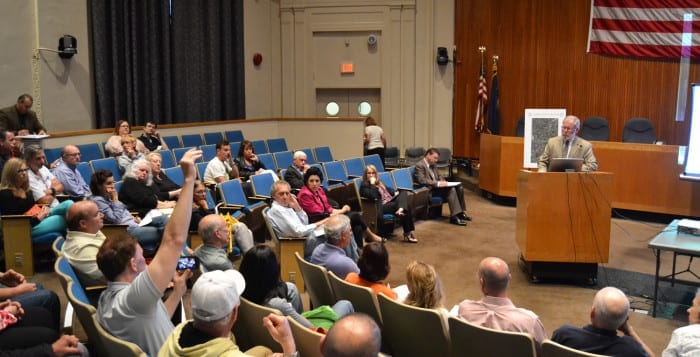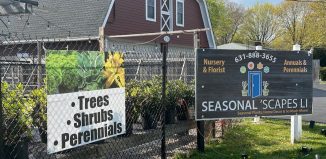Amid resident protest, engineers call for few Woodbury Road changes

Findings on a traffic study for the heavily traveled Woodbury Road fell short of some residents expectations Monday night, when engineers recommended against adding traffic signals or stop signs on the thoroughfare that connects Huntington and Cold Spring Harbor.
GEB HiRise, the Uniondale engineering firm that spent 10 months on the project, announced the results of their traffic study to about 60 residents at Huntington Town Hall, at a meeting sponsored by Councilwoman Susan Berland (D).
Martin Doherty, GEB HiRise senior traffic engineer, said the firm conducted the study over 10 days, laying rubber tubes across the road that tracked both the volume and speed of traffic.
Despite resident reports of dangerous traffic activity on the road, GEB HiRise recommended only minor changes.
Doherty said during his presentation that the maximum speed clocked on the road over the 10-day study was 76 mph, by a car passing by at night. For the bulk of drivers traveling on Woodbury Road during the study, the average speed was 44 mph.
The speed limit on the road is 30 mph.
Doherty said larger and more reflective signs; thicker lane markings; rumble strips in the double yellow lines in the center of the road; reduced speed limits in some areas from 30 to 25 mph; and narrower lanes in some areas were the most drastic changes GEB HiRise recommended. The firm also suggested adding permanent overhead radar detectors in some spots — the kind that tell drivers how fast they are going, in the hopes of making them aware of excessive speed.
The study results did not suggest adding stop signs or traffic signals to the road.
The study deemed stop signs to be an ineffective solution because they would increase the number of rear-end collisions and create heavy delays, according to Doherty.
“I’m almost at a loss because it’s a lot to take in,” Woodbury Road resident Marilyn McDermott said after the meeting Monday. “I had my own expectations coming in of what I thought would be helpful.”
McDermott started a petition last summer to have the traffic study done. Her driveway leads directly onto the thoroughfare. McDermott said she arranged for her child’s school bus driver to come up her driveway in the morning because the road is too dangerous for anyone to stand on while waiting for a bus.
“You hear the study say that it doesn’t call for [stop signs],” McDermott said. “It makes us take a deep breath and say, ‘OK if it’s not [warranted], then are we turning this into a highway?’ … None of us want to have that kind of a road.”
There were moments during the meeting when the crowd became audibly frustrated with some of Doherty’s recommendations.
“How many people have to die before we get some damn stop signs?” one resident called out before exiting the meeting. He said he feared his agitation would trigger an existing heart problem.
Residents said they believed many of the worst offenders driving on Woodbury Road are people who are trying to make it to the Cold Spring Harbor train station in time for a train.
Berland reiterated that the study simply made recommendations about improving conditions on the road. She collected note cards from residents who wanted to share their opinions, and plans to consider them before action is taken, she said.
“We’re going to collate all of that, put all of that together and then I’m going to sit with the supervisor and our director of traffic, go through everything and see where we go,” Berland said.
Residents voiced concerns with numerous aspects of the study. Some were unhappy that it was conducted over a span of only 10 days, while others said that some of the data collected would be skewed because drivers were aware of the fact that their speed was being tracked. Also, residents who live on side streets of Woodbury Road were frustrated that their difficulties in making turns onto the curved main road were not taken into account in the study.
Resident suggestions made during the meeting included asking the police department for an increased presence and adding speed cameras.
Mayer Horn, a Dix Hills resident and transportation engineering consultant, offered a different view.
“Let me stress one word,” Horn said. “It’s not enforcement. It’s not stop signs. It’s not signals. People who asked you for those things mean well, but they’re misguided. The key word is ‘compliance.’ That’s what we really want here.”






